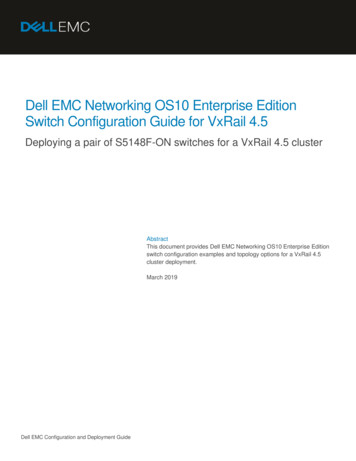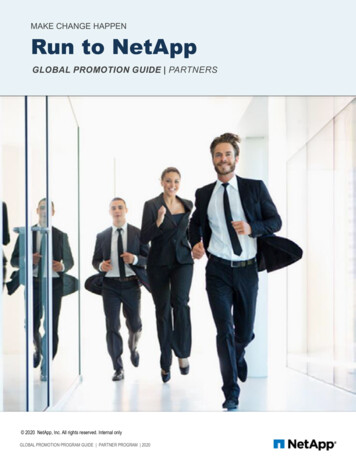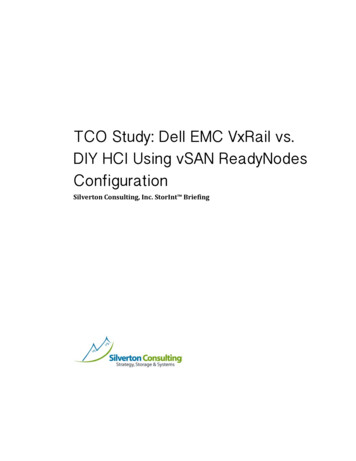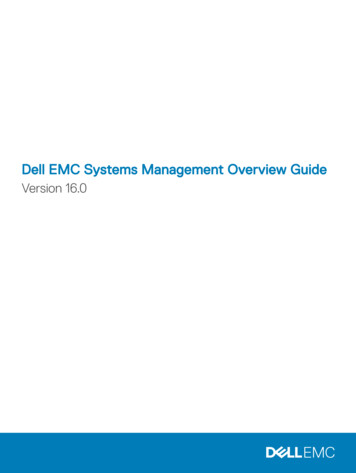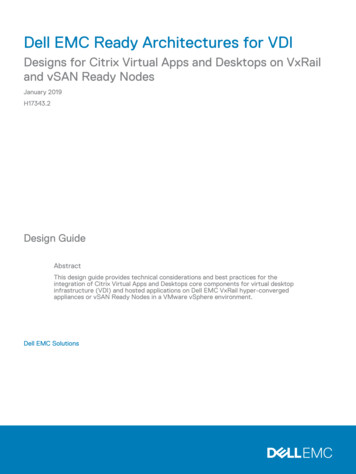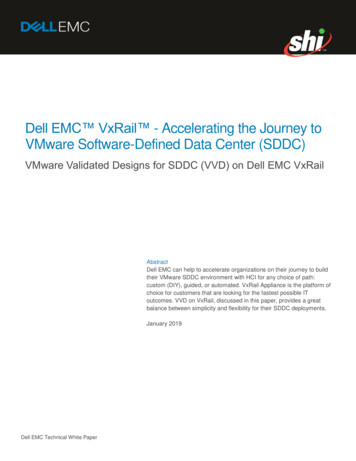
Transcription
Dell EMC VxRail - Accelerating the Journey toVMware Software-Defined Data Center (SDDC)VMware Validated Designs for SDDC (VVD) on Dell EMC VxRailAbstractDell EMC can help to accelerate organizations on their journey to buildtheir VMware SDDC environment with HCI for any choice of path:custom (DIY), guided, or automated. VxRail Appliance is the platform ofchoice for customers that are looking for the fastest possible IToutcomes. VVD on VxRail, discussed in this paper, provides a greatbalance between simplicity and flexibility for their SDDC deployments.January 2019Dell EMC Technical White Paper
RevisionsRevisionsDateDescriptionJan 18, 2019Minor updates based on the additional feedback received.Dec 17, 2018Initial release.AcknowledgementsThis paper was produced by the VxRail and VxRack SDDC Technical Marketing team.Content Owner: Karol BoguniewiczThe information in this publication is provided “as is.” Dell Inc. makes no representations or warranties of any kind with respect to the information in thispublication and specifically disclaims implied warranties of merchantability or fitness for a particular purpose.Use, copying and distribution of any software described in this publication requires an applicable software license. 2019 Dell Inc. or its subsidiaries. All Rights Reserved. Dell, EMC, Dell EMC and other trademarks are trademarks of Dell Inc. or its subsidiaries. Othertrademarks may be trademarks of their respective owners.Dell believes the information in this document is accurate as of its publication date. The information is subject to change without notice.2Dell EMC VxRail - Accelerating the Journey to VMware Software-Defined Data Center (SDDC) H17552
AcknowledgementsTable of contents1Business IT challenges and trends .71.1Business IT challenges .71.2Trend to converged and hyper-converged infrastructures .81.3Trend to virtualization and software-defined infrastructures .81.3.1 Software-defined data center (SDDC) solution .91.42Trend to public and hybrid cloud .10VMware software-defined data center (SDDC) .122.1VMware SDDC vision .122.1.1 IT service delivery automation .132.1.2 SDDC platform automation .142.1.3 Security .142.1.4 Hybrid cloud ready .162.2VMware SDDC architecture approaches .162.3VMware Validated Designs (VVD).172.3.1 Standardized data center level design .172.3.2 Proven and robust designs .182.3.3 Applicable to a broad set of scenarios .192.3.4 Comprehensive documentation .193VVD on VxRail .203.1Accelerate journey to the VMware hybrid cloud with Dell EMC .203.2Why Dell EMC VxRail Appliance is the platform of choice for VVD .213.2.1 VVD on VxRail certification .213.2.2 VxRail software .223.2.3 VxRail Manager .223.2.4 VxRail flexible hardware configurations .263.2.5 Dell EMC Fabric Design Center support for VxRail .273.2.6 Dell EMC support.283.2.7 Dell EMC Professional Services .303.2.8 Future-Proof Loyalty Program .303.3VVD on VxRail hardware architecture .314Conclusion .32AReferences .33BVMware SDDC product details .34B.1VMware common SDDC components .34B.1.1 VMware vSphere .343Dell EMC VxRail - Accelerating the Journey to VMware Software-Defined Data Center (SDDC) H17552
AcknowledgementsB.1.2 VMware vSAN .35B.1.3 VMware NSX .36B.1.4 vRealize Suite .37B.2VMware Validated Designs (VVD) technical implementation .38B.2.1 VVD multi-region architecture .39B.2.2 Availability zones (vSAN stretched cluster) .40B.2.3 VVD implementation options .41B.3VMware Cloud Foundation .41B.3.1 Key features and capabilities .41B.3.2 SDDC Manager .42COptional VMware integrated data protection options .43C.1Dell EMC Data Protection Suite for VMware .44C.1.1 Dell EMC RecoverPoint for Virtual Machines .454Dell EMC VxRail - Accelerating the Journey to VMware Software-Defined Data Center (SDDC) H17552
Executive summaryExecutive summaryInformation Technology (IT) departments are under significant pressure to deliver new applications to market,to innovate with technology to beat competitors and to do it faster with more choice. At the same time, thereare requirements for stricter compliance, improved security, controlled costs and increased efficiency. Tosolve these problems, the modern data center is trending towards converged and hyper-convergedinfrastructures, virtualization and software-defined infrastructures and public and hybrid cloud solutions.The VMware vision of the modern data center is a software-defined, standardized architecture. It is a fullyintegrated hardware and software stack, simple to manage, monitor and operate. The VMware architecturefor the software-defined data center (SDDC) empowers companies to run hybrid clouds and to leverageunique capabilities to deliver key outcomes that enable efficiency, agility and security. The VMware SDDC isbased on VMware vSphere , VMware vSAN and VMware NSX to provide compute, storage and networkingvirtualization to the SDDC and on the VMware vRealize Suite for additional management, self-service,automation, intelligent operations and financial transparency.VMware sees three paths for building an SDDC: Custom, “Do It Yourself” (DIY)Guided with VMware Validated Designs (VVD)Automated with VMware Cloud Foundation Dell EMC shares VMware’s vision of the modern data center and extends that to the infrastructure. With VVDon VxRail, Dell EMC provides services and additional automation beyond the self-guided VVD path. It is thesolution that provides the best combination of design flexibility, integration, automation and speed ofdeployment for most customers.Dell EMC provides a full range of cloud platforms to accelerate digital business transformation with less riskand greater savings, offering varying levels of pre-engineered solutions for VMware, Pivotal and Microsoftbased clouds. Dell EMC’s best-of-breed hardware is combined with the right level of integration, tooling anddocumentation to accelerate business results, simplify daily operations and achieve greater levels ofefficiency and transparency.This whitepaper explains why Dell EMC’s VxRail is the platform of choice for customers who would like toaccelerate the journey to the VMware hybrid-cloud.VxRail is a fully integrated hyper-converged appliance that enables a software-defined data center. TheVxRail Appliance is architected with a software stack for appliance management, virtualization, and VMmanagement. VxRail Manager provides: automation and orchestration for day 0 to day 2 appliance-basedoperational tasks, single-click upgrades of hardware firmware components and software, and monitoring withdashboards for health, events and detailed physical node views.Dell EMC is #1 in hyper-converged systems, all based on the Dell EMC PowerEdge server platform. VxRailAppliances are jointly engineered by Dell EMC and VMware and are the only fully integrated, preconfiguredand tested HCI appliance powered by VMware vSAN technology for software-defined storage. Dell EMC hascompleted the certification process for the VMware Validated Design Certified Partner Architecture on theVxRail making it the only HCI appliance currently certified for the VVD.VxRail nodes are available with different hardware configurations varying the compute power, memory,cache, storage and GPU configurations to closely match the requirements of new and expanding use cases.As requirements grow, the system easily scales out and scales up in granular increments. VxRail software5Dell EMC VxRail - Accelerating the Journey to VMware Software-Defined Data Center (SDDC) H17552
Executive summaryincludes VxRail Manager for appliance management, operations and automation and can offer additional dataprotection options integrated with VMware. VxRail greatly simplifies the infrastructure management viaautomation, lifecycle management (LCM), and configuration flexibility so you can deploy the infra for aVMware SDDC to most closely match your workload needs,Dell EMC support is recognized with over a 95% customer satisfaction rating1 and has received multipleawards. Dell EMC Professional Services offers ProDeploy installation and implementation services to ensuresmooth and rapid integration of VxRail Appliances into customer networks and consulting for the VMwarestack. Dell EMC simplifies the process of VxRail fabric creation, administration and operation with automateddesign, fabric creation and operation. Dell EMC also protects customer investment with the future-proofloyalty program.In short, by deploying VVD on VxRail, customers can accelerate time to market, de-risk deployment andoperations, increase efficiency, drive IT agility, operate in confidence and future-proof their infrastructure toget ready for VMware hybrid cloud.This paper also includes references of where to look for more information and there are appendices toprovide additional detail on VMware products used in the SDDC, VMware Validated Designs, VMware CloudFoundation and some of the complimentary VMware integrated data protection options from Dell ise-suitebrochure.pdf6Dell EMC VxRail - Accelerating the Journey to VMware Software-Defined Data Center (SDDC) H17552
Business IT challenges and trends1Business IT challenges and trends1.1Business IT challengesTechnology is transforming the way we live and work at an ever-increasing pace. This is a new digital era. It isthe dawn of the Internet of Everything (IOT), what many have called the next industrial revolution. Whileprevious industrial eras were driven by steam, coal and electricity, this one is driven by data. It is ruthlesslychanging the business landscape and reinventing our future.Business Information Technology (IT) departments are under significant pressure. IT is no longer justresponsible for keeping the lights-on and treated as a cost center. IT is becoming a business partner,responsible for playing a significant role in digital transformation. There is an imperative to deliver newapplications to market, to innovate with technology to beat competitors and to do it faster with more choice. Atthe same time there are requirements for stricter compliance, improved security, controlled costs andincreased efficiency. Lowering risk with disaster recovery (DR) and business continuity (BC) solutionsbecomes even more critical.Traditional IT infrastructure is custom designed to fit a business’ particular needs using any solution from anyvendor. This flexibility comes with drawbacks, including the extensive time needed to research and get theinitial or expanded infrastructure ordered, installed and ready to deploy applications. Infrastructure frommultiple hardware and software vendors leads to separately managed operational silos, relying on multiple ITstaff with different areas of expertise. Without centralized management, achieving security and compliance ismuch more difficult. When there is a problem, support issues may get stuck in circular finger pointing wherevendors blame one another. Even with careful planning, upgrades run into complications and increased riskfrom interactions between products from different vendors.Each product in this type of legacy stack is likely to be grossly overprovisioned, using its own resources(CPU, memory and storage) to address the intermittent peak workloads of resident applications. The value ofa single shared resource pool, offered by server virtualization, is still generally limited to the server layer. Allother components, such as networks and storage, are islands of overprovisioned resources that are often notshared. Therefore, low utilization of the overall stack results in the ripple effects of high acquisition, space andpower costs. Too many resources are wasted in traditional legacy environments.The physical infrastructure consists of complex hardware silos that are difficult to manage or automate.Regular maintenance tasks and hardware outages require expensive downtime. Mitigating the problem usingdedicated standby hardware is expensive. The hardware-centric architecture results in operationalinefficiencies because of factors such as the limited capacity of the CPUs in running applications, a singleoperating system image per machine and inflexible infrastructure that is difficult to troubleshoot.These problems can be mitigated by trading off a highly flexible choice of vendors and applications forbuilding the infrastructure with a more restricted infrastructure that is easier to support and maintain.Traditional IT can use product compatibility lists to help alleviate multi-vendor support issues by limiting thescope of solutions that can be considered for use to products included in the compatibility list. However,without easy automation solutions and with limited IT staff, achieving compliance is still very challenging.7Dell EMC VxRail - Accelerating the Journey to VMware Software-Defined Data Center (SDDC) H17552
Business IT challenges and trends1.2Trend to converged and hyper-converged infrastructuresBoth converged and hyper-converged infrastructures limit the choice of multi-vendor products, reducing thetime, cost and risk of deploying, configuring and managing hardware and software components separately.Converged infrastructure (CI) is largely systems integration, where an entire solution is built and sold as asingle unit.CI systems take the responsibility of system integration and validation of infrastructure components off thehands of customers and assure lifecycle management. Customers can spin up virtual machines, containersand even bare metal servers without having to worry about selecting, integrating or upgrading theinfrastructure. A custom management interface and a combination of professional services for setup andupgrades shortens the time to get the solution running.Hyper-converged infrastructure (HCI) software defines the storage that is installed inside individual serversinto a single, shared pool of storage and then runs workloads on those same servers. HCI uses softwaredefined technologies to provide compute, storage, and networking infrastructure services rather than usingtraditional purpose built hardware components. HCI is usually deployed on standard server components;providing a simplified scale-out architecture with intelligence and rich data services moved to the softwarelayer. With a much narrower set of potential hardware and software combinations, HCI vendors morethoroughly test their hardware and software stack, providing easier software and hardware upgrades.Organizations are transforming from traditional do-it-yourself infrastructure and adopting CI and HCI solutionsto help them meet their business IT challenges. With CI and HCI infrastructures, multiple pre-engineered andpre-integrated components operate under a single controlled architecture with a single point-of-managementand a single source for end-to-end support. HCI provides a localized single resource pool that enables ahigher overall resource utilization than can be achieved with legacy infrastructure. Overall total cost ofownership (TCO) is lower with operational savings from simplified management. In the data center, HCItypically has a smaller footprint with less cabling and can be deployed much faster and at lower total cost thantraditional infrastructure.Industry infrastructure deployment is transforming as customers begin to shift from a “build” to a “consume”approach. This deployment shift is being driven by the need for IT to focus limited economic and humancapital resources on driving business innovation, which results in fewer resources available to focus oninfrastructure. While a “build-your-own” deployment strategy can achieve a productive IT infrastructure, thisstrategy can be difficult and lengthy to implement, vulnerable to higher operating costs and susceptible togreater risk related to component integration, configuration, qualification, compliance and management.A “consume” deployment strategy for HCI provides the benefits of previously integrated, configured, qualifiedand compliant components. Purchasing an HCI system provides a single optimized IT solution that is quickand easy to deploy. A “consume” deployment strategy for HCI provides a simple and effective alternative to“build-your-own” and it has been widely adopted.1.3Trend to virtualization and software-defined infrastructuresVirtualization transforms physical systems into a virtual environment by creating a logical version of a deviceor resource - anything from a server to an operating system. Virtualization helps solve problems withutilization and rapid scalability. Without virtualization, traditional server utilization is typically in only the 6% to12% range.Traditional hardware comes in fixed sizes and is hard to scale and fully utilize. Virtualization allowsorganizations to purchase more powerful equipment with better performance and put many optimally-sizedvirtualized resources on it. Technologies such as overprovisioning, automatic load balancing, clustering andparallel processing optimize resources and improve uptime. Virtualization technology emulates hardware8Dell EMC VxRail - Accelerating the Journey to VMware Software-Defined Data Center (SDDC) H17552
Business IT challenges and trendsusing software that hides details of the underlying physical hardware. Multiple hardware components and thefunctionality of that hardware can be efficiently emulated on less expensive, non-specialized hardware.Server virtualization is mature and proven technology with high adoption rates in data centers of all sizes.Both storage and network virtualization are growing trends. Storage virtualization groups physical storagefrom multiple storage devices so that it looks like a single storage device. Software-defined storage (SDS)includes storage virtualization and goes further to abstract all storage services from hardware devices usingsoftware to create, deploy and manage storage resources and infrastructure. SDS enables expensiveproprietary storage solutions to be replaced with software-defined storage that utilizes x86 technology. Byutilizing industry-standard x86 technology, SDS helps eliminate the need for storage area networks (SANs)and proprietary storage expertise. Organizations can also reduce their storage footprint, which lowers hostingand cooling costsSoftware-defined networking (SDN) is a computer networking architecture that separates the data plane fromthe control plane in routers and switches. The control plane is implemented in servers using software and isseparate from networking hardware. The data plane is implemented in networking hardware. In traditionalnetworking, when a data packet arrives at a switch or router, the firmware tells the hardware where to forwardthe packet and sends all packets to that destination via the same path. All packets are treated the same. Moreadvanced smart switches equipped with application-specific integrated circuits (ASICs) recognize differenttypes of packets and treat them differently based on the ASIC programming. These switches, however, areexpensive.SDN decouples networking control from the hardware’s firmware. The network administrator can centrallyconfigure network traffic without changing the settings of individual switches. The administrator can changenetwork rules, prioritization and selectively block packets with greater control. SDN provides better control ofnetwork traffic and offer better security options while using less expensive commodity switches as theunderlying hardware layer.1.3.1Software-defined data center (SDDC) solutionCombining server, storage and network virtualization together leads to a completely software-definedinfrastructure. The Why, the What and the How of the Software-Defined Data Center (Osterman Research,May 2017) identifies the business benefits of the SDDC solution:Improved speed and productivity of IT staff Because of its software-defined nature, with proper tools, an SDDC is easier to configure, reconfigureand keep secure, resulting in IT operations that are more responsive to change and more efficient.SDDC also permits frequent service updates and rapid standup/teardown of test environments.Improved security SDDC’s software-defined nature enables consistently-enforced policies that act on logical, abstractedcharacteristics of the workload and its data. Traditional data center operations must distribute rulesacross a range of different hardware devices that will need to be manually updated with inevitablehardware and configuration changes. In an SDDC, relevant policies remain in place and automaticallyadjust to changes in the underlying physical environment of SDDC workloads.Improved utilization of hardware 9Virtualization increases the hardware utilization, allowing organizations to make more efficient use oftheir capital expenditures. For example, it allows several workloads to share software-definedDell EMC VxRail - Accelerating the Journey to VMware Software-Defined Data Center (SDDC) H17552
Business IT challenges and trendscomputing, storage and network resources. SDDC unifies networking functions using non-specializedhardware avoiding lock-in to specific networking equipment.Enabled interoperable cloud 1.4SDDC helps organizations realize the benefits of hybrid clouds without vendor or technology lock-in.The combination of automation, abstraction, visibility and control fosters consistency that will ease theplacing of workloads into public or private clouds to an even greater extent than virtualization alonewould permit.Trend to public and hybrid cloudThe ability of cloud computing to offer solutions to the business IT challenges stated above is driving moreorganizations to use cloud computing as a key part of their IT infrastructure. Cloud computing provides anoption to entirely replace a hardware data center with a service offering where it is not necessary to beconcerned about the underlying hardware supporting it. Cloud computing can also extend a hardware datacenter by providing on-demand resources faster, in smaller increments and reduces the capital andoperational expense of adding hardware to the data center.The National Institute of Standards and Technology (NIST) provides a definition of cloud computing.Cloud computing is a model for enabling ubiquitous, convenient, on-demand network access to ashared pool of configurable computing resources (e.g., networks, servers, storage, applications, andservices) that can be rapidly provisioned and released with minimal management effort or serviceprovider interaction. This cloud model is composed of five essential characteristics, three servicemodels, and four deployment models.2The five essential characteristics of cloud computing are:1.2.3.4.5.On-demand self-serviceBroad network accessResource poolingRapid elasticityMeasured serviceA public cloud is formed when a cloud provider makes computing resources publicly available over theinternet. In a public cloud, setup for a consumer is usually quick and easy. Users pay for resources usedrather than for direct hardware. Some providers also charge a subscription fee. If more resources are needed,the cloud can instantly provide them. There is no need to install additional hardware or software. One of theconcerns and barriers for organizations using the public cloud is data security and governance.Private cloud describes a computing infrastructure privately held by an organization that has capabilitiessimilar to a public cloud but is completely internal and therefore more secure. Virtualization provides manycloud-like resource allocation features. The addition of cloud management tools can be used to build a privatecloud.Hybrid cloud supports an organization's applications on a mix of private and public clouds. Applications thatprovide strategic value to the organization and may contain sensitive information are often kept on a l/sp/800-145/finalDell EMC VxRail - Accelerating the Journey to VMware Software-Defined Data Center (SDDC) H17552
Business IT challenges and trendscloud, while a public cloud is used for everything else. There are many reasons, including the cost of rewritinglegacy applications to run in a new e
The VMware vision of the modern data center is a software-defined, standardized architecture. It is a fully integrated hardware and software stack, simple to manage, monitor and operate. The VMware architecture for the software-defined data center (SDDC) empowers companies to run hybrid clouds and to leverage
